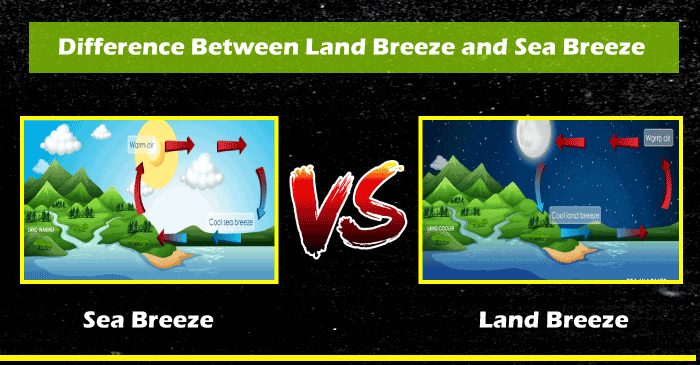Difference between Land Breeze and Sea BreezeNature is indescribable. There are a lot of places where nature is at its best. One of the best parts of nature is the breeze. We have all studied about two significant kinds of breeze in our primary classes. These are the land breeze and sea breeze. Now, what is a breeze? Well, a breeze is a gentle wind that blows at a certain speed. We come in contact with breeze every day. It is in our surroundings and environment. Both these land breeze and sea breeze occur in or near large water bodies like oceans, sea, etc. Both land and sea breeze are important because they are a kind of relief from the hot and humid climate conditions. Well, it is important to note that we must not confuse wind with the breeze. Both are different. When the air is gently flowing, it is called a breeze. But when the air becomes harsh, it is called wind. Now, let us discuss the definition of land breeze and sea breeze. 
Land BreezeA land breeze is defined as a breeze that flows towards the sea from land. This flowing of breeze takes place at night when there is relative warmth in the sea. The land breeze ends in water. Due to this, an air convergence is produced. In layman's language, the land breeze is the flow of air from land to the sea at night. Land breeze is shallow than the sea breeze. Land breeze is formed at night when the oceans and land lose heat. The capacity of heat that the land carries becomes low, due to which it cools down rapidly. Examples of places where land breeze happens include oceans, sea, lakes, etc. Land breeze is caused because of the fact that the land cools at a faster rate than the sea at night. Thus, the warm air of the sea rises, and it leads to the cooling of the air, resulting in the land breeze. Sea BreezeA sea breeze is defined as the breeze that flows towards the land from the sea. Sea breeze happens during the day. It occurs in summers because there is unequal heating between land and water. The land heats at a faster rate than the water in summers, and due to this, the breeze above land is warmer than the sea. Because of this, the sea breeze takes place. In layman's language, the sea breeze is the breeze that moves from sea to land during the day. In summers, the air above the land is warm, and it rises above to cool in the sea, leading to a sea breeze. For example, the heat in the summer season is moderated by the winds from the mountains in the north (in the month of August and September). The sea breeze is important because it helps in overcoming fatal storms. People living on the East Coast are able to overcome such storms because of the sea breeze. Now, there are a number of contrasting points between the land breeze and sea breeze. So, let us take a look at them.
So, these are some of the significant contrasting points between the land breeze and sea breeze. The temperature is relatively cooler in the sea breeze as compared to the land breeze. Now, both breezes have certain characteristics associated with them. So, let us take a look at them. Features of Land Breeze & Sea Breeze
So, these are some of the characteristics of land breeze and sea breeze. Both land and sea breeze have certain differences that are listed above. Both of them are responsible for making the land and water cool during the day and night. Thus, land breeze and sea breeze are essential parts of the environment that helps in lowering the temperatures.
Next TopicDifference between
|
 For Videos Join Our Youtube Channel: Join Now
For Videos Join Our Youtube Channel: Join Now
Feedback
- Send your Feedback to [email protected]
Help Others, Please Share










